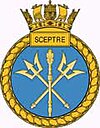
The Swiftsure class was a class of nuclear-powered fleet submarines in service with the Royal Navy from the early 1970s until 2010.
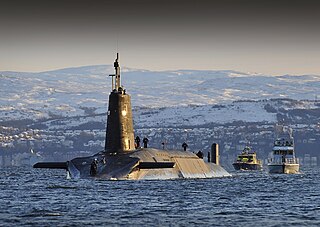
The Vanguard class is a class of nuclear-powered ballistic missile submarines (SSBNs) in service with the Royal Navy. The class was introduced in 1994 as part of the Trident nuclear programme, and comprises four vessels: Vanguard, Victorious, Vigilant and Vengeance, built between 1986 and 1999 at Barrow-in-Furness by Vickers Shipbuilding and Engineering, now owned by BAE Systems. All four boats are based at HM Naval Base Clyde , 40 km (25 mi) west of Glasgow, Scotland.

HMS Astute is an operational nuclear-powered attack submarine in the Royal Navy, the lead boat of her class.

HMS Triumph is a Trafalgar-class nuclear submarine of the Royal Navy and was the seventh and final boat of her class. She is the nineteenth nuclear-powered hunter-killer submarine built for the Royal Navy. Triumph is the tenth vessel, and the second submarine, to bear the name. The first HMS Triumph was a 68-gun galleon built in 1561. As of 2022, she is the last boat of her class remaining in service.

HMS Turbulent is a retired Trafalgar-class submarine of the Royal Navy and the second vessel of her class. Turbulent was the fifth vessel, and second submarine, of the Royal Navy to bear this name. She was built by Vickers Shipbuilding, Barrow-in-Furness, and based at HMNB Devonport. She was commissioned in 1984 and decommissioned in July 2012. She was stripped of equipment and now awaits dismantling in number 3 Basin at Devonport.

HMS Tireless was the third Trafalgar-class nuclear submarine of the Royal Navy. Tireless is the second submarine of the Royal Navy to bear this name. Launched in March 1984, Tireless was sponsored by Sue Squires, wife of Admiral 'Tubby' Squires, and commissioned in October 1985.
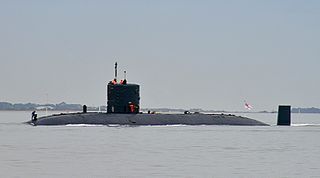
HMS Torbay is a decommissioned Trafalgar-class nuclear submarine of the Royal Navy and the fourth vessel of her class. Torbay was the fifth vessel and the second submarine of the Royal Navy to be named after Torbay in Devon, England. The first vessel was the 80-gun second rate HMS Torbay launched in 1693.

HMS Talent is the sixth of seven Trafalgar-class nuclear submarines operated by the Royal Navy from 1990 until 2022. It was built at Barrow-in-Furness.

HMS Ambush is an Astute-class nuclear-powered attack submarine of the Royal Navy, the second boat of her class.

The seventh Royal Navy ship to be named HMS Dreadnought was the United Kingdom's first nuclear-powered submarine, built by Vickers Armstrongs at Barrow-in-Furness. Launched by Queen Elizabeth II on Trafalgar Day 1960 and commissioned into service with the Royal Navy in April 1963, she continued in service until 1980. The submarine was powered by a S5W reactor, a design made available as a direct result of the 1958 US–UK Mutual Defence Agreement.

The eleventh HMS Vanguard of the Royal Navy is the lead boat of her class of Trident ballistic missile-armed submarines. The submarine is based at Faslane, HMNB Clyde, Argyll, Scotland.

The latest HMS Warspite was the third of Britain's nuclear-powered submarines, and the second of the Valiant class. After entering service in 1967 she collided with a Soviet submarine the following year. A mechanical failure associated with the submarine's nuclear reactor in 1991 led to the boat being laid up at HMNB Devonport where she awaits disposal.
HMS Sovereign was a Swiftsure-class nuclear-powered fleet submarine of the Royal Navy.

The Commander-in-Chief Fleet (CINCFLEET) was the admiral responsible for the operations of the ships, submarines and aircraft of the British Royal Navy from 1971 until April 2012. The post was subordinate to the First Sea Lord, the professional head of the Naval Service. In its last years, as the Navy shrank, more administrative responsibilities were added.

His Majesty's Naval Base, Clyde, primarily sited at Faslane on the Gare Loch, is one of three operating bases in the United Kingdom for the Royal Navy. It is the navy's headquarters in Scotland and is best known as the home of Britain's nuclear weapons, in the form of nuclear submarines armed with Trident missiles.
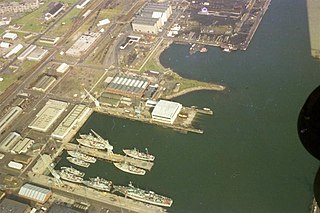
Rosyth Dockyard is a large naval dockyard on the Firth of Forth at Rosyth, Fife, Scotland, owned by Babcock Marine, which formerly undertook refitting of Royal Navy surface vessels and submarines. Before its privatisation in the 1990s it was formerly the Royal Naval Dockyard Rosyth. Its primary role now is the dismantling of decommissioned nuclear submarines. It is also the integration site for the Royal Navy's newest aircraft carriers, the Queen Elizabeth class as well as the Type 31 Frigate.
HMS Swiftsure was the lead ship of her class of nuclear fleet submarines built for the Royal Navy. Entering service in 1973, she served until 1992.

HMS Audacious is the fourth Astute-class nuclear-powered fleet submarine of the Royal Navy. Several previous vessels of the Royal Navy have borne the name. She was formally named on 16 December 2016 and was launched on 28 April 2017. Audacious was stated to be handed over in January 2021. A parliamentary written answer stated that Audacious was commissioned on 3 April 2020, but her public ceremonial commissioning took place on 23 September 2021.
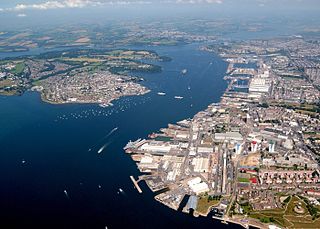
His Majesty's Naval Base, Devonport is one of three operating bases in the United Kingdom for the Royal Navy and is the sole nuclear repair and refuelling facility for the Royal Navy. The largest naval base in Western Europe, HMNB Devonport is located in Devonport, in the west of the city of Plymouth, England.
In 1989 the Royal Navy was under the direction of the Navy Department in the UK Ministry of Defence. It had two main commands, CINCFLEET and Naval Home Command.
